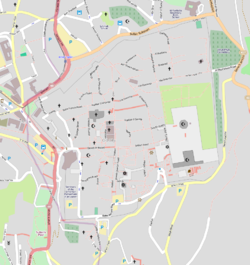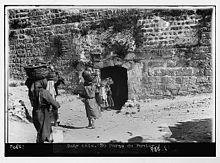- Dung Gate
-
Dung Gate
Dung GateGeneral information Town or city Jerusalem The Dung Gate (also known as Sha'ar Ha'ashpot, Gate of Silwan, Mograbi Gate, Arabic: باب المغاربة) is one of the gates in the walls of the Old City of Jerusalem.
The gate is situated near the southeast corner of the old city, southwest of the Temple Mount.
The gate is the closest to the Western Wall and is a main passage for vehicles. It was originally much smaller, but was enlarged in 1952, after the Old City came under Jordanian control in 1948. After its capture by Israel in 1967, architect Shlomo Aronson was commissioned to renovate this gate.[1] Directly behind the gate lies the entrance to the Western Wall compound.
Name
The name Sha'ar Ha'ashpot appears in the Book of Nehemiah:3:13-14. It is probably named after the residue that was taken from the Jewish Temple into the Valley of Hinnom, where it was burned. This ancient "Dung Gate" may not have been in the same location as the modern gate.
The name Mograbi gate (Bab al-Magharibeh) refers to the Moroccan Quarter or (Mughrabi quarter) now destructed, which was situated near the area.
References
- ^ Shlomo Aronson. "Landscape Selected Projects List by Shlomo Aronson". Archived from the original on 2008-04-27. http://web.archive.org/web/20080427225855/http://s-aronson.co.il/Selected-Projects-List.html. Retrieved 2008-06-13.
External links
Coordinates: 31°46′29″N 35°14′2″E / 31.77472°N 35.23389°E
Old City of Jerusalem Gates Damascus · Dung · Golden · Herod's · Jaffa
Lions’ · New · Zion · HuldahWalls Western Wall · Southern Wall Categories:- Israel stubs
- Israel geography stubs
- Gates in Jerusalem's Old City Walls
- Western Wall
- Ezra-Nehemiah
Wikimedia Foundation. 2010.




